MASTER SWORD CHOREOGRAPHERS
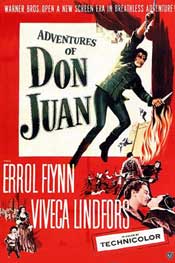 During the heyday of the swashbuckler, the genius behind the few believable duels was not a director like Curtiz, Tourneur, Mamoulian, or Walsh, nor a star like Flynn or Power. It was Fred Cavens. During the heyday of the swashbuckler, the genius behind the few believable duels was not a director like Curtiz, Tourneur, Mamoulian, or Walsh, nor a star like Flynn or Power. It was Fred Cavens.
Even in an absurd situation as with The Adventures of Robin Hood (1938), when Cavens was called upon to choreograph broadsword duels as though they were rapiers, the mixed effect has an unsettling realism. (As an aside, the archery was doubled by champion archer Howard hill, who really did split that arrow!)
Less unsettling, of course, is when rapiers are used as rapiers, as in Adventures of Don Juan (1948) with excellent Cavens choreography.
Cavens was a French graduate of the Belgian Military Institute & a fine swordsmaster by any measure. He believed screen duels should be realistic in terms of the situation rather than letter-perfect in terms of tournament regulation or classically correct moves.
This left him open to choreographing a "dirty" fight with tables upturned & the like. He also felt duels should be spectacular as screen images without ever becoming silly, illogical, or unworkable. The later work of Jean Heremans was often frankly silly, not because he was an inferior swordsman, but because he lacked Cavens' sense of screen dignity of action.
When Cavens worked with actors with real fencing skill, he could truly make the duels remarkable. Douglas Fairbanks, Jr., unlike his father, genuinely understood the sword.
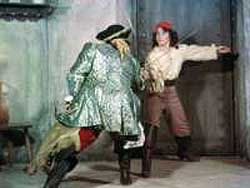 His ability shows in The Corsican Brothers (1941). Cornel Wilde in At Swords's Point aka Sons of the Musketeers (1952) likewise did his best work with Cavens' coaching. Cornel's very real expertise with the weapon allowed phenomenal duels to be engineered. His ability shows in The Corsican Brothers (1941). Cornel Wilde in At Swords's Point aka Sons of the Musketeers (1952) likewise did his best work with Cavens' coaching. Cornel's very real expertise with the weapon allowed phenomenal duels to be engineered.
In contrast, when Cavens was working with stars lacking experience with the blades, he still worked miracles.
He is the real force behind the excellent duels in The Spanish Main (1945), Anne of the Indies (1951), The Sea Hawk (1940) & The Three Musketeers (1935 version, still the best).
Cavens coached Power for The Black Swan (1942) & The Mark of Zorro (1940). Powers had sufficient physical grace that it's surprising to realize he just couldn't do swordplay well.
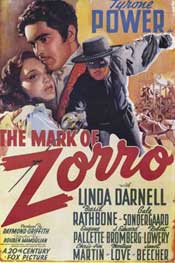 Mark of Zorro's villain was played by Basil Rathbone who was a legitimate fencing master & always did his own work on screen, genuinely collaborating with Fred. It's one of the great filmic ironies that one of the most skilled of screen swordsmen is the only one never got to have won a duel, being always the bad guy. Mark of Zorro's villain was played by Basil Rathbone who was a legitimate fencing master & always did his own work on screen, genuinely collaborating with Fred. It's one of the great filmic ironies that one of the most skilled of screen swordsmen is the only one never got to have won a duel, being always the bad guy.
In Captain Blood (1935) as attested to Basil himself, Erroll Flynn was so incorrigible on the set that he made the duels more dangerous than they needed to be. Basil's task was to help make Erroll look skilled rather than absurd as he in fact was. And Basil had to fight an urge to just run him through.
Cavens with Rathbone's assistance made Flynn & Tyrone look pretty damned good in Captain Blood & Mark of Zorro, pulling out every trick in the book to disguise the reality that neither star could fence. But Tyrone in The Black Swan has some "speeded up" action that makes him look a bit like a wind-up toy, & that problem is even worse for Binnie Barns' big duel in Anne of the Indies.
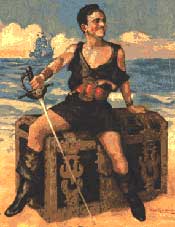 Fred also had bit parts in some of the films he choreographed, including Cyrano de Bergerac (1950), The Fortunes of Captain Blood (1950), At Sword's Point, & many others, in which he always revealed his own great fencing skills. He was often playing his real life occupation, that of a fencing instructor, but transposed into period settings. Fred also had bit parts in some of the films he choreographed, including Cyrano de Bergerac (1950), The Fortunes of Captain Blood (1950), At Sword's Point, & many others, in which he always revealed his own great fencing skills. He was often playing his real life occupation, that of a fencing instructor, but transposed into period settings.
Even more often we see only his back in films, when he is doubling for actors who could not perform their own swordfights. There's no way of knowing for sure how often we're seeing him, since films weren't promoted with the confession that the given star was a klutz. In The Corsican Brothers it is definitely Cavens rather than Akim Tamiroff fighting Cornel Wilde, while Wilde expertly handles his own weapon.
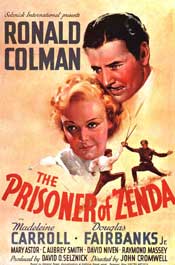 Not everything Cavens touched was guaranteed top drawer. His silent film work included The Black Pirate (1926), pure entertainment with excessively exaggerated swordplay. He also set up the mediocre duels in Man in the Iron Mask (1939). Not everything Cavens touched was guaranteed top drawer. His silent film work included The Black Pirate (1926), pure entertainment with excessively exaggerated swordplay. He also set up the mediocre duels in Man in the Iron Mask (1939).
Cavens was not the one & only choreographer capable of good work. Ralph Faulkner was a sabre & epee champion in the Olympics (1928 & 1932), hired by Cavens as a stunt man & fencing double, who eventually became Cavens' chief rival in the business.
Faulkner's chreography for Prisoner of Zenda (1937) is milestone work. Unlike Cavens, however, he acquired a ponderous number of assignments for films of small merit & his grand ability was wasted on horrible productions.
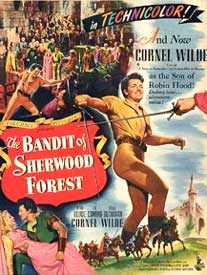 Prisoner of Zenda, in which he was also a villain, must stand as his chief & crowning achievement. If there are other exceptions they're to be found in his collaborations with Cornel Wilde. Prisoner of Zenda, in which he was also a villain, must stand as his chief & crowning achievement. If there are other exceptions they're to be found in his collaborations with Cornel Wilde.
Post-war swashbuckler heroes like John Derek, Richard Greene, et al, had the image but not the ability. Faulkner was less skilled than Cavens in disguising the limitations of these actors.
Cornel Wilde, however, was expert at riding, fencing, & archery. He'd been a fencing champion in his college days & was himself briefly a choreographer for live stage duels.
So he had a conviction other post-war swashbuckler stars lacked, even though the films showcasing him were often lackluster cream puffs.
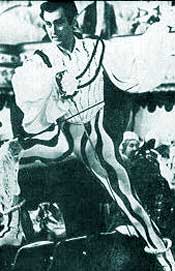 Still, with Faulkner's coaching he reveals his authentic talents in Bandit of Sherwood Forest (1947) & he saves Omar Khayyam (1957) & other films from being totally worthless. Still, with Faulkner's coaching he reveals his authentic talents in Bandit of Sherwood Forest (1947) & he saves Omar Khayyam (1957) & other films from being totally worthless.
Belgian fencing champion Jean Heremans appeared on the scene rather late. His earliest choreographic work was in 1948. Thus his name is not associated with the great classics of the mid-30s through 40s.
None the less, his work on Three Musketeers (1948) included a for-the-time record-setting five minute screen duel. And he broke his own record with the six & a half minute duel in Scaramouche (1952).
His work was sometimes awful as in the truly klutzy broadsword technique with oversized, underweight props in Prince Valiant (1952); sometimes competent but not inspired as in the color remake of Prisoner of Zenda (1952), & sometimes quite good as in Swordman of Siena (1962).
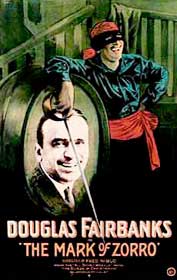 In the early silent films the stylized nature of the violence, & the fact that America lacked Europe's body of fencing experts to draw upon, did not allow for the immediate inclusion of the kind of skilled swordplay that had long graced England & Europe's live theaters. Thus pre-1920s silent swashbucklers are pretty whimsical when it comes to swordfights.
In the early silent films the stylized nature of the violence, & the fact that America lacked Europe's body of fencing experts to draw upon, did not allow for the immediate inclusion of the kind of skilled swordplay that had long graced England & Europe's live theaters. Thus pre-1920s silent swashbucklers are pretty whimsical when it comes to swordfights.
In 1920, though, another French swordsmaster, Henry J. Uttenhove, made Douglas Fairbanks, Sr., appear to be a passing fair swordsman in the original The Mark of Zorro.
This was a turning point for swordsmanship in the cinema, which opened up a whole new world to Americans who had not formerly known much about fencing arts.
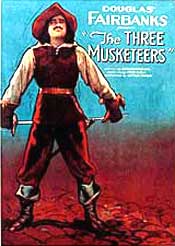 That fencing would begin to appear in the middle-school system among other sports was all but entirely the doing of Doug, Sr. That fencing would begin to appear in the middle-school system among other sports was all but entirely the doing of Doug, Sr.
Although he could not personally fence, he looked like he could when Uttenhove put him through a few paces, which Doug dressed up with winning smiles & gracefully leaping about.
In silent film versions of Prisoner of Zenda (1922), The Three Musketeers (1921), & Monte Cristo (1922), Uttenhove insured Doug., Sr., Romon Narrow, & John Gilbert the illusion of expertise with sword.
Uttenhove concentrated on correct sword handling, but the larger screen situations were too often unreal, especially with Doug, Sr., who would rather do stunts than duel in any convincing manner.
Uttenhove's contribution to swordplay action is unquestionably great, since the silent films set the tone for the genre, & that tone is echoed right into the present. But it is Fred Cavens who must be credited as the premiere stylist whose behind-the-scenes contributions to the swashbuckler were the most profound, & remain an influence upon the cinema to this very day.
copyright © by Paghat the Ratgirl
|


 His ability shows in The Corsican Brothers (1941). Cornel Wilde in
His ability shows in The Corsican Brothers (1941). Cornel Wilde in 
 Fred also had bit parts in some of the films he choreographed, including Cyrano de Bergerac (1950), The Fortunes of Captain Blood (1950), At Sword's Point, & many others, in which he always revealed his own great fencing skills. He was often playing his real life occupation, that of a fencing instructor, but transposed into period settings.
Fred also had bit parts in some of the films he choreographed, including Cyrano de Bergerac (1950), The Fortunes of Captain Blood (1950), At Sword's Point, & many others, in which he always revealed his own great fencing skills. He was often playing his real life occupation, that of a fencing instructor, but transposed into period settings.  Not everything Cavens touched was guaranteed top drawer. His silent film work included
Not everything Cavens touched was guaranteed top drawer. His silent film work included  Prisoner of Zenda, in which he was also a villain, must stand as his chief & crowning achievement. If there are other exceptions they're to be found in his collaborations with Cornel Wilde.
Prisoner of Zenda, in which he was also a villain, must stand as his chief & crowning achievement. If there are other exceptions they're to be found in his collaborations with Cornel Wilde. Still, with Faulkner's coaching he reveals his authentic talents in Bandit of Sherwood Forest (1947) & he saves Omar Khayyam (1957) & other films from being totally worthless.
Still, with Faulkner's coaching he reveals his authentic talents in Bandit of Sherwood Forest (1947) & he saves Omar Khayyam (1957) & other films from being totally worthless.
 That fencing would begin to appear in the middle-school system among other sports was all but entirely the doing of Doug, Sr.
That fencing would begin to appear in the middle-school system among other sports was all but entirely the doing of Doug, Sr.